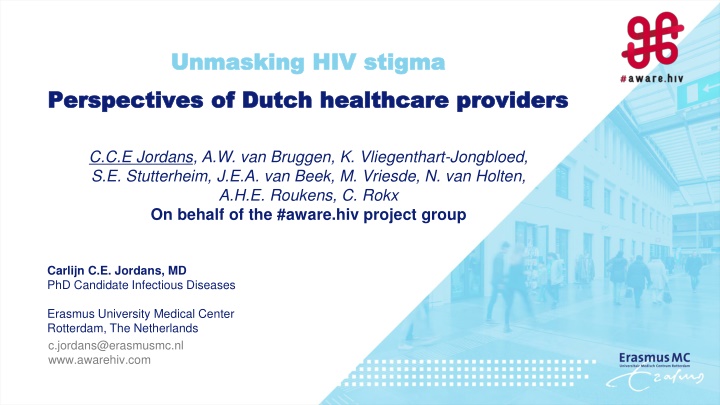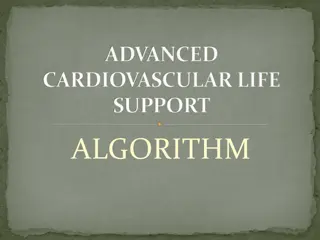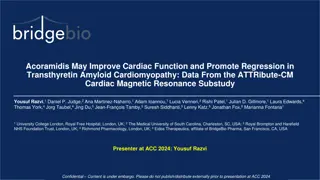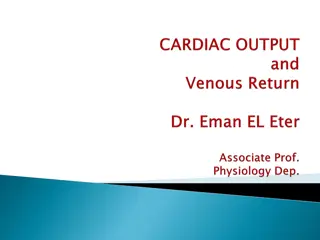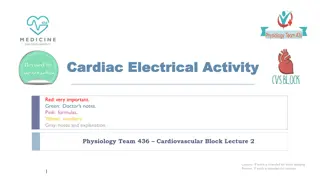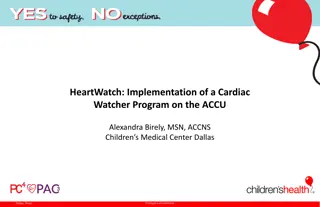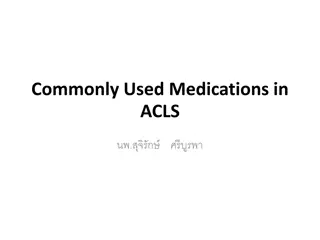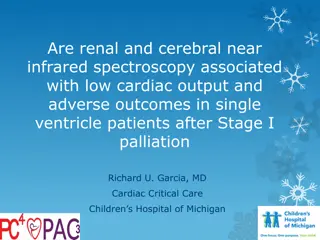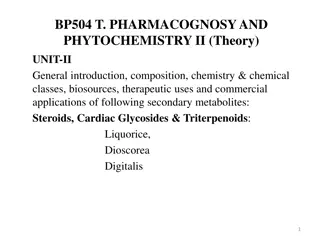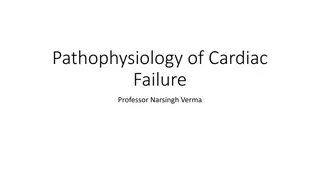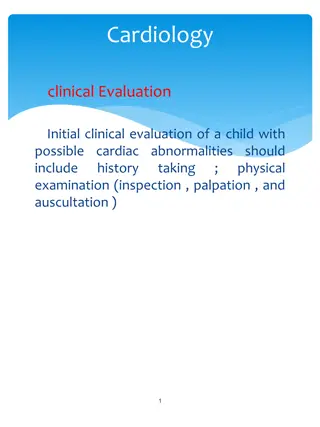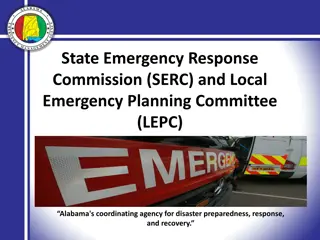Advanced Cardiac Life Support (ACLS) Interventions and Importance in Emergency Medicine
ACLS encompasses clinical interventions for cardiac arrest and life-threatening emergencies, following AHA protocols as the gold standard. Built upon Basic Life Support (BLS) principles, ACLS involves evidence-based responses essential for prompt life-saving actions. Understanding the AHA Adult Chain of Survival is crucial, emphasizing rapid recognition, CPR, defibrillation, advanced support, and post-arrest care. High-quality CPR in BLS involves ensuring scene safety, recognizing cardiac arrest, and activating the emergency response system promptly.
Download Presentation

Please find below an Image/Link to download the presentation.
The content on the website is provided AS IS for your information and personal use only. It may not be sold, licensed, or shared on other websites without obtaining consent from the author.If you encounter any issues during the download, it is possible that the publisher has removed the file from their server.
You are allowed to download the files provided on this website for personal or commercial use, subject to the condition that they are used lawfully. All files are the property of their respective owners.
The content on the website is provided AS IS for your information and personal use only. It may not be sold, licensed, or shared on other websites without obtaining consent from the author.
E N D
Presentation Transcript
Unmasking HIV stigma Unmasking HIV stigma Perspectives of Dutch healthcare providers Perspectives of Dutch healthcare providers C.C.E Jordans, A.W. van Bruggen, K. Vliegenthart-Jongbloed, S.E. Stutterheim, J.E.A. van Beek, M. Vriesde, N. van Holten, A.H.E. Roukens, C. Rokx On behalf of the #aware.hiv project group Carlijn C.E. Jordans, MD PhD Candidate Infectious Diseases Erasmus University Medical Center Rotterdam, The Netherlands c.jordans@erasmusmc.nl www.awarehiv.com
Disclosures Disclosures This work was supported by the Dutch Federation Medical Specialist (Stichting Kwaliteitsgelden federatie Medisch Specialisten) I have received travel reimbursement from Gilead Sciences and compensation for a presentation from ViiV Healthcare.
HIV stigma HIV stigma HIV stigma impacts the full cascade of care and remains stubbornly persistant UNAIDS set the 10%target to end the HIV epidemic to reach by 2025 <10% of people living with HIV should experience stigma and discrimination Research on the perspectives of people living with HIV shows an increase in experienced stigma in Dutchhealthcaresettings over the past decade Aim of this study: to investigate HIV stigma in healthcare settings from the perspective of healthcare workers
Methods Methods A cross-sectional survey was conducted between April and August 2023 Two tertiary centers (ErasmusMC and LUMC) Relevant questions for healthcare workers were selected from a standardizedquestionnaire for HIV stigma Questionnaire was distributed to all healthcare workers by mail and through focussed meetings at large departments
Prevalence Prevalence of HIV stigma of HIV stigma HIV stigma indicators: Fear of infection Observed and anticipated stigma and discrimination Institutional-level facilitators and barriers Attitudes towards people living with HIV Barriers discussing HIV with patients
Participants Participants Participants, n (%) 59 (18.8) 209 (66.6) 46 (14.6) 231 (73.6) 81 (25.8) 2 (0.6) 157 (50.0) 70 (22.3) 57 (18.2) 30 (9.5) 48 (15.3) 35 (11.1) 27 (8.6) 22 (7.0) 20 (6.4) 19 (6.1) 19 (6.1) 15 (4.8) 12 (3.8) 11 (3.5) 11 (3.5) 10 (3.2) 9 (2.9) 56 (17.8) 282 (89.8) 28 (8.9) 4 (1.3) Median (IQR) 32 (27-39) Missing, n (%) Age (years) - 25 26 45 46 Gender - Female Male Other Occupation - Nurse Resident Medical specialist Other Department(s) - Internal medicine Emergency department Pulmonology Ear, nose, throat Neurosurgery Gastroenterology/hepatology Cardiothoracic surgery Oncology Acute admission department Gastroenterology/hepatology/surgery Dermatology Surgery Infectious diseases other City of work - Rotterdam Leiden Other Years worked in healthcare Number of treated patients with HIV per year 8.0 (4.9-15.0) 2 (0.6) 4.0 (IQR 2.0- 8.0) - Received training on the following topics: HIV stigma and discrimination Infection control and universal precautions Patient s informed consent, privacy, and 31 (10.2) 132 (42.0) 127 (40.4) 47 (15.0) 136 (43.3) 178 (56.7) - confidentiality Key population stigma and discrimination Received no training in one of these topics Received any of above training
Participants Participants Participants workedinhealthcare for a median of 8.0 years (IQR 4.9-15.0 years) Participant treated a median number of 4.0 patients with HIV per year (IQR 2.0-8.0 patients) Most were working at the internalmedicinedepartment (n=48, 15.3%), and the emergency department (n=35, 11.1%) The minority (n=31, 10.2%) received any training on HIV stigma and discrimination
F Fear ear of The five HIV stigma indicators measured by an adapted version of the standardized questionnaire Measuring HIV stigma and discrimination among health facility staff: indicator monitoring tool * Fear of HIV infection Worry of HIV when conducting the following activities: of infection infection Not worried, n (%) 284 (90.7) 94 (31.5) 71 (24.0) Worried, n (%) Touch clothing of a patient living with HIV (n=313) Dress wounds of a patient living with HIV (n=298) Draw blood from a patient living with HIV (n=296) Any worry to get HIV infected (n=314) 29 (9.3) 204 (68.5) 225 (76.0) No, n (%) 81 (25.8) Yes , n (%) 233 (74.2) Use of precautionary measures when providing care to patients living with HIV: Avoid physical contact (n=303) Wear double gloves (n=302) Any use of precautionary measures (n=303) No, n (%) Yes, n (%) 283 (93.4) 252 (83.4) 20 (6.6) 50 (16.6) No, n (%) 238 (78.5) Yes, n (%) 65 (21.5) Observed stigma and discrimination Observed at your health facility in the last 12 months Never, n (%) At least once, n (%) 9 (3.6) Healthcare providers unwilling to care for a patient living with HIV (n=252) Healthcare providers providing poorer quality of care to a patient living with HIV compared to other patients (n=252) Any observed stigma and discrimination (n=253) 243 (96.4) 235 (93.3) 17 (6.7) No, n (%) 231 (91.3) Yes, n (%) 22 (8.7) Institutional facilitators and barriers Policies on discrimination No, n (%) 14 (4.6) 7 (2.3) Yes, n (%) 176 (57.3) 57 (18.4) Don t know, n (%) 117 (38.1) I will get in trouble at work if I discriminate against patients living with HIV (n=307) My health facility has written guidelines to protect patients living with HIV from discrimination (n=309) Policies on reducing the risk of HIV infection There are adequate supplies in my health facility that reduce my risk of becoming infected with HIV (n=309) There are standardized procedures/protocol in my health facility that reduce my risk of becoming infected with HIV (n=309) Attitudes towards people living with HIV Level of agreement with the following statements: Most people living with HIV do not care if they infect other people (n=302) People living with HIV should feel ashamed of themselves (n=302) People get infected with HIV because they engage in irresponsible behaviors (n=301) Women living with HIV should be allowed to have babies if they wish (n=301)** Any negative attitudes (n=302) 245 (79.3) Agree, n (%) 298 (96.4) Disagree, n (%) 11 (3.6) 287 (92.9) 22 (7.1) Agree, n (%) 27 (8.9) Disagree, n (%) 275 (91.1) 3 (1.0) 299 (99.0) 33 (11.0) 268 (89.0) 265 (88.0) 36 (12.0) Yes, n (%) No, (%)
The five HIV stigma indicators measured by an adapted version of the standardized questionnaire Measuring HIV stigma and discrimination among health facility staff: indicator monitoring tool * Fear of HIV infection Worry of HIV when conducting the following activities: Not worried, n (%) 284 (90.7) 94 (31.5) 71 (24.0) Worried, n (%) Touch clothing of a patient living with HIV (n=313) Dress wounds of a patient living with HIV (n=298) Draw blood from a patient living with HIV (n=296) Any worry to get HIV infected (n=314) 29 (9.3) 204 (68.5) 225 (76.0) No, n (%) 81 (25.8) Yes , n (%) 233 (74.2) Use of precautionary measures when providing care to patients living with HIV: Avoid physical contact (n=303) No, n (%) Yes, n (%) Observed Observed stigma Wear double gloves (n=302) Any use of precautionary measures (n=303) stigma 283 (93.4) 252 (83.4) 20 (6.6) 50 (16.6) No, n (%) 238 (78.5) Yes, n (%) 65 (21.5) Observed stigma and discrimination Observed at your health facility in the last 12 months Never, n (%) At least once, n (%) 9 (3.6) Healthcare providers unwilling to care for a patient living with HIV (n=252) Healthcare providers providing poorer quality of care to a patient living with HIV compared to other patients (n=252) Any observed stigma and discrimination (n=253) 243 (96.4) 235 (93.3) 17 (6.7) No, n (%) 231 (91.3) Yes, n (%) 22 (8.7) Institutional facilitators and barriers Policies on discrimination No, n (%) 14 (4.6) 7 (2.3) Yes, n (%) 176 (57.3) 57 (18.4) Don t know, n (%) 117 (38.1) I will get in trouble at work if I discriminate against patients living with HIV (n=307) My health facility has written guidelines to protect patients living with HIV from discrimination (n=309) Policies on reducing the risk of HIV infection There are adequate supplies in my health facility that reduce my risk of becoming infected with HIV (n=309) There are standardized procedures/protocol in my health facility that reduce my risk of becoming infected with HIV (n=309) Attitudes towards people living with HIV Level of agreement with the following statements: Most people living with HIV do not care if they infect other people (n=302) People living with HIV should feel ashamed of themselves (n=302) People get infected with HIV because they engage in irresponsible behaviors (n=301) Women living with HIV should be allowed to have babies if they wish (n=301)** Any negative attitudes (n=302) 245 (79.3) Agree, n (%) 298 (96.4) Disagree, n (%) 11 (3.6) 287 (92.9) 22 (7.1) Agree, n (%) 27 (8.9) Disagree, n (%) 275 (91.1) 3 (1.0) 299 (99.0) 33 (11.0) 268 (89.0) 265 (88.0) 36 (12.0) Yes, n (%) No, (%)
The five HIV stigma indicators measured by an adapted version of the standardized questionnaire Measuring HIV stigma and discrimination among health facility staff: indicator monitoring tool * Fear of HIV infection Worry of HIV when conducting the following activities: Not worried, n (%) 284 (90.7) 94 (31.5) 71 (24.0) Worried, n (%) Touch clothing of a patient living with HIV (n=313) Dress wounds of a patient living with HIV (n=298) Draw blood from a patient living with HIV (n=296) Any worry to get HIV infected (n=314) 29 (9.3) 204 (68.5) 225 (76.0) No, n (%) 81 (25.8) Yes , n (%) 233 (74.2) Use of precautionary measures when providing care to patients living with HIV: Avoid physical contact (n=303) Wear double gloves (n=302) Any use of precautionary measures (n=303) No, n (%) Yes, n (%) 283 (93.4) 252 (83.4) 20 (6.6) 50 (16.6) No, n (%) 238 (78.5) Yes, n (%) 65 (21.5) Observed stigma and discrimination Observed at your health facility in the last 12 months Never, n (%) At least once, n (%) 9 (3.6) Healthcare providers unwilling to care for a patient living with HIV (n=252) Healthcare providers providing poorer quality of care to a 243 (96.4) Institutional Institutional facilitators patient living with HIV compared to other patients (n=252) Any observed stigma and discrimination (n=253) facilitators 235 (93.3) 17 (6.7) No, n (%) 231 (91.3) Yes, n (%) 22 (8.7) Institutional facilitators and barriers Policies on discrimination No, n (%) 14 (4.6) 7 (2.3) Yes, n (%) 176 (57.3) 57 (18.4) Don t know, n (%) 117 (38.1) I will get in trouble at work if I discriminate against patients living with HIV (n=307) My health facility has written guidelines to protect patients living with HIV from discrimination (n=309) Policies on reducing the risk of HIV infection There are adequate supplies in my health facility that reduce my risk of becoming infected with HIV (n=309) There are standardized procedures/protocol in my health facility that reduce my risk of becoming infected with HIV (n=309) Attitudes towards people living with HIV Level of agreement with the following statements: Most people living with HIV do not care if they infect other people (n=302) People living with HIV should feel ashamed of themselves (n=302) People get infected with HIV because they engage in irresponsible behaviors (n=301) Women living with HIV should be allowed to have babies if they wish (n=301)** Any negative attitudes (n=302) 245 (79.3) Agree, n (%) 298 (96.4) Disagree, n (%) 11 (3.6) 287 (92.9) 22 (7.1) Agree, n (%) 27 (8.9) Disagree, n (%) 275 (91.1) 3 (1.0) 299 (99.0) 33 (11.0) 268 (89.0) 265 (88.0) 36 (12.0) Yes, n (%) No, (%)
The five HIV stigma indicators measured by an adapted version of the standardized questionnaire Measuring HIV stigma and discrimination among health facility staff: indicator monitoring tool * Fear of HIV infection Worry of HIV when conducting the following activities: Not worried, n (%) 284 (90.7) 94 (31.5) 71 (24.0) Worried, n (%) Touch clothing of a patient living with HIV (n=313) Dress wounds of a patient living with HIV (n=298) Draw blood from a patient living with HIV (n=296) Any worry to get HIV infected (n=314) 29 (9.3) 204 (68.5) 225 (76.0) No, n (%) 81 (25.8) Yes , n (%) 233 (74.2) Use of precautionary measures when providing care to patients living with HIV: Avoid physical contact (n=303) Wear double gloves (n=302) No, n (%) Yes, n (%) A Attitudes ttitudes towards with with HIV HIV Any use of precautionary measures (n=303) towards people people living 283 (93.4) 252 (83.4) No, n (%) 238 (78.5) living 20 (6.6) 50 (16.6) Yes, n (%) 65 (21.5) Attitudes towards people living with HIV Level of agreement with the following statements: Most people living with HIV do not care if they infect other people (n=302) People living with HIV should feel ashamed of themselves (n=302) People get infected with HIV because they engage in irresponsible behaviors (n=301) Women living with HIV should be allowed to have babies if they wish (n=301)** Any negative attitudes (n=302) Agree, n (%) 27 (8.9) Disagree, n (%) 275 (91.1) 3 (1.0) 299 (99.0) 33 (11.0) 268 (89.0) 265 (88.0) 36 (12.0) Yes, n (%) 80 (26.5) No, (%) 222 (73.5) Barriers discussing HIV and risk factors with patients Level of difficulty discussing the following topics: The possibility of an HIV infection (n=240) The need to test for HIV (n=244) Risk factors for HIV (n=244) HIV-related topics when a patient is accompanied by a family member (n=251) Any difficulties discussing HIV and risk factors (n=257) Easy, n (%) 135 (56.2) 201 (82.4) 168 (68.9) 77 (30.7) Difficult, n (%) 105 (43.8) 43 (17.6) 76 (31.1) 174 (69.3) No, n (%) 71 (27.6) Yes, n (%) 186 (72.4)
The five HIV stigma indicators measured by an adapted version of the standardized questionnaire Measuring HIV stigma and discrimination among health facility staff: indicator monitoring tool * Fear of HIV infection Worry of HIV when conducting the following activities: Not worried, n (%) 284 (90.7) 94 (31.5) 71 (24.0) Worried, n (%) Touch clothing of a patient living with HIV (n=313) Dress wounds of a patient living with HIV (n=298) Draw blood from a patient living with HIV (n=296) Any worry to get HIV infected (n=314) 29 (9.3) 204 (68.5) 225 (76.0) No, n (%) 81 (25.8) Yes , n (%) 233 (74.2) Use of precautionary measures when providing care to patients living with HIV: Avoid physical contact (n=303) Wear double gloves (n=302) Any use of precautionary measures (n=303) No, n (%) Yes, n (%) 283 (93.4) 252 (83.4) 20 (6.6) 50 (16.6) No, n (%) 238 (78.5) Yes, n (%) 65 (21.5) Attitudes towards people living with HIV Level of agreement with the following statements: Most people living with HIV do not care if they infect other people (n=302) People living with HIV should feel ashamed of themselves (n=302) People get infected with HIV because they engage in irresponsible behaviors (n=301) Women living with HIV should be allowed to have babies if Agree, n (%) 27 (8.9) Disagree, n (%) 275 (91.1) 3 (1.0) 299 (99.0) 33 (11.0) 268 (89.0) Barriers Barriers discussing discussing HIV they wish (n=301)** Any negative attitudes (n=302) HIV 265 (88.0) 36 (12.0) Yes, n (%) 80 (26.5) No, (%) 222 (73.5) Barriers discussing HIV and risk factors with patients Level of difficulty discussing the following topics: The possibility of an HIV infection (n=240) The need to test for HIV (n=244) Risk factors for HIV (n=244) HIV-related topics when a patient is accompanied by a family member (n=251) Any difficulties discussing HIV and risk factors (n=257) Easy, n (%) 135 (56.2) 201 (82.4) 168 (68.9) 77 (30.7) Difficult, n (%) 105 (43.8) 43 (17.6) 76 (31.1) 174 (69.3) No, n (%) 71 (27.6) Yes, n (%) 186 (72.4)
HIV stigma per HIV stigma per subgroup subgroup Healthcare workers 25 years worried more about acquiring HIV at work (OR 44.3, p<0.001), used more precautionary measures (OR 3.0, p=0.026), and expressed more negative attitudes towards people living with HIV (OR 41.2, p<0.001) Nurses worriedmore abouth acquiringHIV at work (OR 2.6, p=0.003), and had more negativeattitudes towards people living with HIV Over 50% of healthcare workers in all departments expressed concernsaboutacquiringHIV at work DifficultiesdiscussingHIV-relatedmatters were comparable across departments (range 60-100%)
Conclusion Conclusion HIVstigma is prevalent among Dutch healthcare workers, more prominent among younger healthcareworkers Targetapproaches to reduce HIV stigma in healthcare are needed In a safe and non-judgment context, target: Concerns about occupationalinfection Overcoming barriers to discussingHIV with patients Reflecting on prejudices against people living with HIV
Questions Questions? ? www.awarehiv.com
